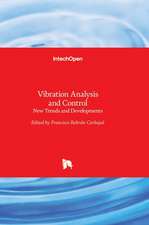Nanotechnology Applications for Solar Energy Systems
Autor M Sheikholeslamen Limba Engleză Hardback – 30 mai 2023
Preț: 1317.84 lei
Preț vechi: 1448.18 lei
-9% Nou
Puncte Express: 1977
Preț estimativ în valută:
252.19€ • 261.70$ • 210.79£
252.19€ • 261.70$ • 210.79£
Carte tipărită la comandă
Livrare economică 17-31 martie
Preluare comenzi: 021 569.72.76
Specificații
ISBN-13: 9781119791140
ISBN-10: 1119791146
Pagini: 448
Dimensiuni: 176 x 253 x 32 mm
Greutate: 0.9 kg
Editura: Wiley
Locul publicării:Chichester, United Kingdom
ISBN-10: 1119791146
Pagini: 448
Dimensiuni: 176 x 253 x 32 mm
Greutate: 0.9 kg
Editura: Wiley
Locul publicării:Chichester, United Kingdom
Cuprins
About the Editor xiii
List of Contributors xv
Preface xix
1 Solar Energy Applications 1
Swati Singh, Punit Singh, and Zafar Said
1.1 Introduction and Recent Advances 1
1.2 Solar Energy Applications 5
1.2.1 Electricity Production Using Photovoltaics at Large Scale 5
1.2.2 Small-Scale Electricity Production for Houses and Commercial Buildings 6
1.2.3 Off-Grid Applications Using Photovoltaics 6
1.2.4 Concentrating Solar Thermal Electricity 7
1.2.5 Solar Thermochemical Processes 7
1.2.6 Solar Water Heating 8
1.2.7 Heating of Solar Architecture 8
1.2.8 Air Conditioning Through Water Evaporation 8
1.2.9 Artificial Photosynthesis 9
1.2.10 Decomposing Waste and Biofuels Production 9
1.3 Classification of Solar Energy Devices 10
1.3.1 Concentrating Solar Power 10
1.3.2 Building Integrated Solar Systems 10
1.3.3 Solar-Thermal Collectors 11
1.3.4 Solar Thermochemistry 11
1.3.5 Solar Thermal Energy Storage 12
1.3.6 Solar-Driven Water Distillation 12
1.4 Benefits and Opportunities 13
1.5 Challenges 16
1.6 Future Aspects 18
1.7 Conclusion 18
References 19
2 Application of Nanofluid for Solar Stills 25
Mohammad Javad Raji Asadabadi , Mohsen Sheikholeslami, and Ladan Momayez
2.1 Introduction 25
2.2 Desalination Technology 25
2.2.1 What is a Solar Still? 26
2.2.2 Parameters Affecting Pure Water Yield of Basin Type SSs 27
2.2.3 Pure Water Augmentation of Solar Still Units 28
2.3 Nanofluid 33
2.3.1 Nanofluid Basics 34
2.3.2 Nanofluid Characteristics 35
2.3.3 Nanofluid Application in Solar Desalination 35
References 43
3 Classification of Concentrating Solar Collectors Based on Focusing Shape and Studying on Their Performance, Financial Evaluation, and Industrial Adoption 49
Z. Ebrahimpour and Mark Mba-Wright
3.1 Introduction 49
3.1.1 Overview of Concentrating Solar Collectors 49
3.1.2 Some of the Applications of Concentrating Solar Collectors 50
3.2 Line Focus Concentrating Solar Collectors 51
3.2.1 Linear Fresnel Reflector 51
3.2.2 Parabolic Trough Collector 53
3.2.3 Compound Parabolic 55
3.3 Point Focus and Other Concentrating Solar Collectors 57
3.3.1 Central Receiver System 57
3.3.2 Solar Dish 59
3.3.3 Fresnel Lens 60
3.4 Improving the Thermal Performance of Solar Concentrating Collectors 62
3.5 Industrial Adoption and Costs of Solar Concentrating Collectors 63
3.6 Conclusions and Recommendations 63
References 66
4 Nanotechnology for Heat Transfer 71
Zafar Said , Maham Aslam Sohail, and Evangelos Bellos
4.1 Introduction 71
4.2 Classification of Nanomaterials 72
4.2.1 Zero-dimensional (0D) 72
4.2.2 One-dimensional (1D) 72
4.2.3 Two-dimensional (2D) 72
4.2.4 Three-dimensional (3D) 73
4.3 Heat Transfer Characteristics and Applications of Nanotechnology on the Heat Transfer Enhancement 73
4.3.1 Convective Heat Transfer 75
4.3.2 Boiling Heat Transfer 77
4.3.3 Thermal Conductivity 77
4.3.4 Viscosity 78
4.4 A Review of Studies and Recent Advances Using Nanomaterials in Energy Conversion, Energy Storage, and Heat Transfer Development 79
4.5 Recent Advances 79
4.6 Challenges and Future Scope 86
4.7 Conclusion 87
References 87
5 Nanofluids in Linear Fresnel Reflector 99
Evangelos Bellos, Zafar Said, and Christos Tzivanidis
5.1 Introduction and Recent Advances of Linear Fresnel Reflectors 99
5.2 The Idea of Using Nanofluids in Solar Collectors 108
5.3 A Review of Studies with Nanofluid-based Linear Fresnel Reflector 112
5.4 Remarks and Future Scope 118
5.4.1 Advantages of LFR 118
5.4.2 Disadvantages of LFR 118
5.5 Conclusions 121
References 121
6 Thermal Management and Performance Enhancement of Parabolic Trough Concentrators Using Nanofluids 125
Muhammed A. Hassan
6.1 Introduction 125
6.2 Recent Advances of Parabolic Trough Collectors 127
6.3 Application of Nanofluids in PTCs 131
6.4 State-of-Art Studies on Using Nanofluids in Parabolic Trough Collectors 136
6.5 Conclusions and Future Scope 139
References 142
7 Developing Innovations in Parabolic Trough Collectors (PTCs) Based on Numerical Studies 145
Sanaz Akbarzadeh, Maziar Dehghan, Mohammad Sadegh Valipour, and Huijin Xu
7.1 Introduction 145
7.2 An Introduction to Simulation Software 148
7.3 Numerical Studies 148
7.3.1 Design Parameters and Working Conditions in PTCs 150
7.3.2 Using Inserts in PTCs 154
7.3.3 Using Surface Modification Methods in PTCs 157
7.3.4 Using Nanofluids in PTCs 160
7.3.5 Using Nanofluids and Other Passive Methods in PTCs 162
7.3.6 PTCs Integrated into Cooling Systems 165
7.3.7 PTCs Integrated into Concentrated Solar Power Plants 166
7.3.8 PTCs Integrated into Solar-powered Cycles 168
7.3.9 PTCs Integrated into Solar Industrial Process Heat Plants 170
7.3.10 PTCs Integrated into Photovoltaic/Thermal (PV/T) System 175
7.3.11 PTCs Integrated into Desalination Systems 175
7.4 Challenges 179
7.5 Conclusion 179
7.6 Future Directions 183
References 183
8 Nanofluids in Solar Thermal Parabolic Trough Collectors (PTCs) 191
Maziar Dehghan, Sanaz Akbarzadeh, Mohammad Sadegh Valipour, and Hafiz Muhammad Ali
8.1 Introduction 191
8.2 Fundamentals of PTCs 194
8.2.1 Components of a PTC 194
8.2.2 Mathematical Formulations of PTCs 195
8.2.3 Experimental Analysis (Standard Test Methods) 203
8.3 Heat Transfer Fluids (HTFs) in PTCs 203
8.3.1 Thermal Oils 204
8.3.2 Liquid-water Steam 204
8.3.3 Pressurized Gasses 204
8.3.4 Molten Salts 204
8.3.5 Nanofluids 204
8.4 Heat Transfer Improvement Methods in PTCs 206
8.4.1 Design Parameters 206
8.4.2 The Application of Nanofluids in PTCs 208
8.4.3 Combination of Nanofluids and Other Thermal Efficiency Enhancement Methods 219
8.5 Economic Analysis 225
8.6 Challenges 228
8.7 Conclusion 228
8.8 Future Directions 229
Acknowledgment 230
References 230
9 Applications of Nanotechnology in the Harvesting of Solar Energy 239
Seyede Mohaddese Mousavi, Zahra Sayah Alborzi, Saba Raveshiyan, and Younes Amini
9.1 Introduction 239
9.1.1 Overview of the Status of the Solar Energy 239
9.1.2 Nanotechnology Overview 240
9.2 Solar Harvesting Technology Using Nanomaterials 242
9.3 Various Modern Solar Harvesting Technologies 242
9.3.1 Solar Collectors 242
9.3.2 Fuel Cells 243
9.3.3 Photocatalysis 243
9.3.4 Solar Photovoltaics 246
9.4 Production Methods of Solar Cell Technology 247
9.4.1 First Generation Solar Cell: Silicon Solar Cells 247
9.4.2 Second Generation Solar Cells: Thin-film Solar Cell 248
9.4.3 Third Generation Solar Cells 250
9.5 Challenges in Using Nanotechnology 251
9.6 Conclusion 252
References 253
10 Tubular Solar Thermal System: Recent Development and Its Utilization 257
Arun Kumar Tiwari and Amit Kumar
10.1 Introduction 257
10.2 Different Tubular Solar System 258
10.2.1 Evacuated Tubular Collector 258
10.2.2 Tubular Solar Still 259
10.2.3 Tubular System for Concentrating Solar Power 262
10.3 Heat Transfer Fluid for the Tubular System 264
10.3.1 Nanofluid 264
10.3.2 Nano-enhanced Molten Salt 264
10.3.3 Liquid Metal 265
10.4 Conclusion 266
References 266
11 Nanofluids in Flat Plate Solar Collectors 273
L. Syam Sundar and Zafar Said
11.1 Nanofluid in Flat Plate Collector 273
11.2 Introduction and Recent Advances of Flat Plate Collectors 273
11.3 Application of Nanofluids in the Flat Plate Collector 276
11.4 A Review of Studies Using Nanomaterials in Flat Pale Collector 281
11.5 Remarks and Future Scope 284
11.6 Conclusion 284
References 285
12 Recent Advances in the Simulation of Solar Photovoltaic Cell Cooling Systems Using Nanofluids 289
Javad Mohammadpour and Fatemeh Salehi
12.1 Introduction 289
12.2 Photovoltaic Thermal (PVT) System 291
12.3 Performance Parameters 291
12.4 An Overview of Numerical Approaches 292
12.5 Previous Research on PVT Systems 294
12.5.1 PVT Nanofluid-Based Systems 294
12.5.2 PVT Multiple-Nanofluid-Based Systems 295
12.5.3 PVT/ PCM Nanofluid-Based Systems 298
12.5.4 Economic Analysis in PVT Studies 299
12.6 Future Works 304
12.7 Conclusions 306
References 306
13 Multiphase Modeling of Powder Flow in an Ejector of Solar-driven Refrigeration System by Eulerian-Lagrangian Approach 313
Mohit Biglarian, Ahmadreza Najafi, Morsal Momeni Larimi, and Masih Parhizkari
13.1 Introduction 313
13.2 Governing Equations 314
13.2.1 Continuity Equation 314
13.2.2 Momentum Equation 314
13.3 Geometry Design and Meshing 315
13.3.1 Generation of the Model 315
13.3.2 Mesh Generation and Study 315
13.3.3 Grid Independency 318
13.3.4 Validation 319
13.4 Results 319
13.4.1 Optimization of the Nozzle 319
13.4.2 Investigation of the Relation between Outlet Velocity and Entrainment Parameter (N) 326
13.4.3 Unsteady Case 327
13.5 Conclusion 335
Declaration of interests 335
References 335
14 Radiative Non-Newtonian Nanofluid Flow through Stretchable Disks: An Application to Solar Thermal Systems 337
S. A. Shehzad, A. Rauf, and M. Omar
14.1 Introduction 337
14.2 Problem Formulation 339
14.3 Numerical Solution 343
14.4 Results and Discussion 344
14.5 Conclusions 351
References 352
15 Cooling of PV/ T System with Nanofluid and PCM 355
Mohit Barthwal, Dibakar Rakshit, and Sujit Kr. Verma
15.1 Introduction 355
15.1.1 Overview 355
15.1.2 Need for Cooling of Photovoltaics 356
15.2 Application of Nanofluid and PCM for Cooling of PV/T System 359
15.2.1 Nanofluids 359
15.2.2 Phase Change Materials 360
15.3 A Review of Studies Using Nanofluid and PCM for Cooling of PV/T System 361
15.4 Remarks and Future Scope 374
15.5 Conclusion 376
Acknowledgment 376
References 377
16 Revival of Functional Nanofluid Photothermal Materials for Solar Still Applications 381
Muhammad Sultan Irshad, Naila Arshad, and Xianbao Wang
16.1 Nanofluid Based Solar Stills 381
16.2 General Factors for Efficient Solar Still 384
16.2.1 Environmental Factors 384
16.2.2 Physical Factors 385
16.3 Development and Modifications 386
16.3.1 Conventional Single-effect Solar Still 386
16.3.2 Solar Reflectors 387
16.3.3 Wicked Type Solar Stills 388
16.4 Application of Nanofluids in Solar Still 388
16.4.1 Methodologies for the Fabrication of Nanofluids 389
16.4.2 Optical Properties of Nanofluids 389
16.4.3 Photothermal of Nanofluids 391
16.5 Carbon-based Nanofluid 391
16.6 Metallic/ Metal Oxide Nanofluids 392
16.7 Magnetic Nanofluids 394
16.8 Solar Thermal Collectors 395
16.9 Solar-driven Steam Generators 397
16.10 Remarks and Future Scope 398
16.11 Conclusion 399
References 400
17 Nanotechnology in Solar Lighting 403
Chao Shen, Changyun Ruan, and Guoquan lv
17.1 Optical Fiber Lighting Based on Sunlight 403
17.2 Radiation Properties of Nanoparticles 405
17.3 Spectral Control of Nanofluid 406
17.3.1 Full Spectrum Absorption Based on Nanofluids 406
17.3.2 Thermal/Electrical Decoupling Control Based on Nanofluids 407
17.4 Design of a Solar Lighting/Heating System 408
17.5 Selection of Nanofluids for the Solar Lighting/Heating System 409
17.6 System Efficiency of the Solar Lighting/Heating System 410
17.7 Spectral Characteristics of Output Light of the Solar Lighting/Heating System 411
17.8 Future Research 413
17.9 Conclusion 414
References 415
Index 421








